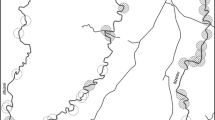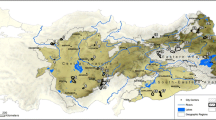Abstract
Hypolestes (Odonata, Zygoptera) is a damselfly genus endemic to the Greater Antilles. The genus comprises three species: H. clara from Jamaica, H. trinitatis from Cuba, and H. hatuey from Hispaniola, which are currently evaluated by the IUCN as Endangered (EN), Vulnerable (VU) and Data Deficient, respectively. Here, we re-assess the conservation status of these species based on their extent of occurrence, as estimated from ecological niche models. In addition, we analyse the coverage offered to each of the three species by the protected areas from Jamaica, Cuba, Dominican Republic and Haiti. Our results support the maintenance H. trinitatis in the category of VU, and suggest the re-classification of H. hatuey as Near Threatened. The estimated extent of occurrence for H. clara is 6422 km2, a value close to the threshold of 5000 km2 between VU and EN. Therefore, we recommend keeping H. clara as EN, until new evidence based on population size and trend could support a change from this category to VU. We found that 14 % of the extent of occurrence for H. clara and H. hatuey, and 33 % for H. trinitatis, are within protected areas. However, the ongoing extensive deforestation in Hispaniola, coupled with the lack of protection in Haiti, could cause a decrease of the extent of occurrence of H. hatuey in the future.


Similar content being viewed by others
References
Alayo P (1968) Las libélulas de Cuba. Torreia 2:1–102
Collins SD, McIntyre NE (2015) Modeling the distribution of odonates: a review. Freshw Sci. doi:10.1086/682688
Corbet PS (2004) Dragonflies, behavior and ecology of odonata. Harley Books, Essex
Corbet PS (2006) Forest as habitats for dragonflies (Odonata). In: Cordero-Rivera A (ed) Forest and dragonflies. Pensoft, Sofia, pp 13–36
Cuevas-Yáñez K, Rivas M, Muñoz J, Córdoba-Aguilar A (2015) Conservation status assessment of Paraphlebia damselflies in Mexico. Insect Conserv Divers. doi:10.1111/icad.12132
Daigle J (1993) A checklist of the Odonata of the Dominican Republic by province. Bull Am Odonatol 1(4):65–69
De Almeida MC, Côrtes LG, De Marco P (2010) New records and a niche model for the distribution of two Neotropical damselflies: Schistolobos boliviensis and Tuberculobasis inversa (Odonata: Coenagrionidae). Insect Conserv Divers 3:252–256. doi:10.1111/j.1752-4598.2010.00096.x
Elith J, Graham CH, Anderson RP et al (2006) Novel methods improve prediction of species’ distributions from occurrence data. Ecography 29:129–151
FAO (2010) Global forest resources assessment 2010. Main report. Food and Agriculture Organization of the United Nations. FAO, Rome
Flint O (1996) The Odonata of Cuba, with a report on a recent collection and checklist of the cuban species. Cocuyo 5:17–20
Flint O, Bastardo RH, Perez-Gelabert DR (2006) Distribution of the Odonata of the Dominican Republic. Bull Am Odonatol 9:67–84
Fontenla JL (2003) Libélulas (Insecta: Odonata) de Sierra de los Órganos. Cocuyo 13:28–29
Hassall C (2012) Predicting the distributions of under-recorded Odonata using species distribution models. Insect Conserv Divers 5:192–201. doi:10.1111/j.1752-4598.2011.00150.x
Hijmans RJ, Guarino L, Cruz M, Rojas E (2001) Computer tools for spatial analysis of plant genetic resources data: 1. DIVA-GIS. Plant Genet Resour Newsl 127:15–19
Hijmans RJ, Cameron SE, Parra JL et al (2005) Very high resolution interpolated climate surfaces for global and land areas. Int J Climatol 24:1965–1978. doi:10.1002/joc.1276
IUCN (2012) IUCN red list categories and criteria: version 3.1, second. IUCN, Gland, Switzerland and Cambridge
IUCN Standards and Petitions Subcommittee (2016) Guidelines for using the IUCN red list categories and criteria. Version 12. Prepared by the standards and petitions subcommittee. Downloadable from http://www.iucnredlist.org/documents/RedListGuidelines.pdf
IUCN, UNEP-WCMC (2014) The world database on protected areas (WDPA), (Sept 2015 version). UNEP-WCMC, Cambridge
Kalkman VJ, Clausnitzer V, Dijkstra K-DB, Orr AG (2008) Global diversity of dragonflies (Odonata) in freshwater. Hydrobiologia 595:351–363. doi:10.1007/s10750-007-9029-x
Merow C, Smith MJ, Silander JA (2013) A practical guide to MaxEnt for modeling species’ distributions: what it does, and why inputs and settings matter. Ecography 36:1058–1069. doi:10.1111/j.1600-0587.2013.07872.x
Nóbrega CC, De Marco P (2011) Unprotecting the rare species: a niche-based gap analysis for odonates in a core Cerrado area. Divers Distrib 17:491–505. doi:10.1111/j.1472-4642.2011.00749.x
Paulson DR (2004) Critical species of Odonata in the Neotropics regional definition state of the art. Int J Odonatol 7:163–188
Paulson DR (2009) Hypolestes clara. In: IUCN 2012. IUCN red list of threatened species. Version 2012.2. www.iucnredlist.org. Accessed 22 June 2013
Pearson RG, Raxworthy CJ, Nakamura M, Peterson AT (2007) Predicting species distributions from small numbers of occurrence records: a test case using cryptic geckos in Madagascar. J Biogeogr 34:102–117. doi:10.1111/j.1365-2699.2006.01594.x
Peterson AT, Soberón J (2012) Species distribution modeling and ecological niche modeling: getting the concepts right. Nat Coservação 10:1–6
Peterson AT, Soberón J, Pearson RG et al (2011) Ecological niches and geographic distributions. Princeton University Press, Princeton
Phillips SJ, Anderson RP, Schapire RE (2006) Maximum entropy modeling of species geographic distributions. Ecol Model 190:231–259. doi:10.1016/j.ecolmodel.2005.03.026
Radosavljevic A, Anderson RP (2014) Making better MAXENT models of species distributions: complexity, overfitting and evaluation. J Biogeogr 41:629–643. doi:10.1111/jbi.12227
Riley SJ, DeGloria SD, Elliot R (1999) A terrain ruggedness index that quantifies topographic heterogeneity. Intermt J Sci 5:23–27
Rissler LJ, Apodaca JJ (2007) Adding more ecology into species delimitation: ecological niche models and phylogeography help define cryptic species in the black salamander (Aneides flavipunctatus). Syst Biol 56:924–942. doi:10.1080/10635150701703063
Sahlén G (1999) The impact of forestry on dragonfly diversity in central Sweden. Int J Odonatol 2:177–186
Shcheglovitova M, Anderson RP (2013) Estimating optimal complexity for ecological niche models: a jackknife approach for species with small sample sizes. Ecol Model 269:9–17
Simaika JP, Samways MJ, Kipping J et al (2013) Continental-scale conservation prioritization of African dragonflies. Biol Conserv 157:245–254. doi:10.1016/j.biocon.2012.08.039
Simard M, Pinto N, Fisher JB, Baccini A (2011) Mapping forest canopy height globally with spaceborne lidar. J Geophys Res Biogeosci. doi:10.1029/2011JG001708
Torres-Cambas Y, Fonseca-Rodríguez R (2011) Sex ratio, survival, and recapture rate in a Cuban population of the damselfly Hypolestes trinitatis (Odonata: Megapodagrionidae). Acta Ethol 14:69–76. doi:10.1007/s10211-011-0095-8
Torres-Cambas Y, Trapero-Quintana A, Lorenzo-Carballa MO et al (2015a) An update on the distribution of threatened odonates species from the greater Antilles. Int J Odonatol 18:89–104. doi:10.1080/13887890.2014.928241
Torres-Cambas Y, Lorenzo-Carballa MO, Ferreira S, Cordero-Rivera A (2015b) Hypolestes hatuey sp. nov.: a new species of the enigmatic genus Hypolestes (Odonata, Hypolestidae) from Hispaniola. Zootaxa 4000:207–226
Trapero-Quintana AD, Naranjo-López C (2003) Revision of the order Odonata in Cuba. Bull Am Odonatol 2:23–40
Warren DL, Glor RE, Turelli M (2010) ENMTools: a toolbox for comparative studies of environmental niche models. Ecography 33:607–611. doi:10.1111/j.1600-0587.2009.06142.x
Warren DL, Wright AN, Seifert SN, Shaffer HB (2014) Incorporating model complexity and spatial sampling bias into ecological niche models of climate change risks faced by 90 California vertebrate species of concern. Divers Distrib 20:334–343. doi:10.1111/ddi.12160
Wellenreuther M, Larson KW, Svensson EI (2012) Climatic niche divergence or conservatism? environmental niches and range limits in ecologically similar damselflies. Ecology 93:1353–1366
Westfall MJ (1976) Taxonomic relationships of Diceratobasis macrogaster (Selys) and Phylolestes ethelae Christiansen of the West Indies as revealed by their larvae. Odonatologica 5:65–76
Acknowledgments
We thank Chris Hassall, R. Isabel Aguirre-Alcolea and two anonymous referees for their valuables comments and suggestions on early versions of the manuscript. YT-C was supported by a project Ciencia y Conciencia funded by Universidad de Oriente (Project Code 9617) and a WDA Conservation Research Grant. MOL-C is funded by the European Commission, through an Individual European Marie Curie Fellowship (PIEFGA-2013-626504—ODOGEN). AC-R was funded by grants from the Spanish Ministry with competences in science, which included FEDER Funds (CGL2008-02799 and CGL2010-11959E).
Author information
Authors and Affiliations
Corresponding author
Ethics declarations
Conflict of interest
The authors declare that they have no conflict of interest.
Electronic supplementary material
Below is the link to the electronic supplementary material.
Rights and permissions
About this article
Cite this article
Torres-Cambas, Y., Cabana-Otero, M., Lorenzo-Carballa, M.O. et al. Conservation status and protection of three Antillean endemic damselflies. J Insect Conserv 20, 277–284 (2016). https://doi.org/10.1007/s10841-016-9862-1
Received:
Accepted:
Published:
Issue Date:
DOI: https://doi.org/10.1007/s10841-016-9862-1




